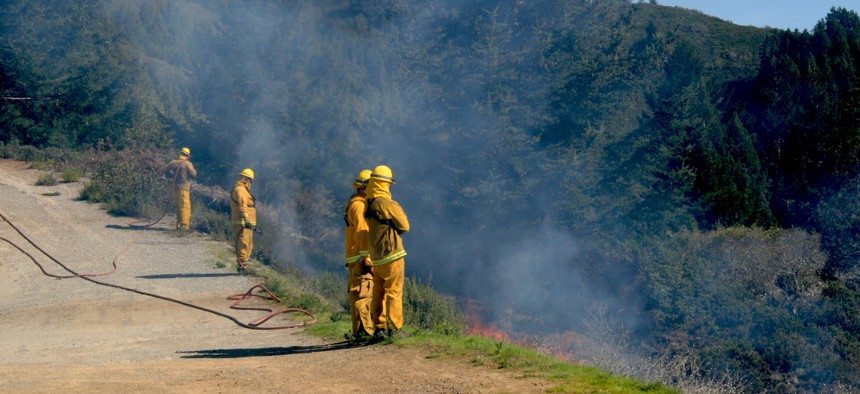
Groups say they appreciate GAO's work but would like to see some additional research to address gaps in the report. Geri Lavrov / Getty Images
Federal Firefighter Groups Find Flaws in a Watchdog's Conclusions on Recruitment, Retention Challenges
GAO didn’t speak to enough frontline firefighters to form a holistic set of recommendations to address the staffing shortage affecting agencies that fight wildfires, groups say.
This story has been updated to include comment from the Government Accountability Office.
Advocates for federal firefighters last week criticized a government watchdog agency because they argued it did not adequately seek the perspective of frontline firefighters to inform a report on recruiting and retention.
Last November, the Government Accountability Office released a report that concluded that the greatest barrier to recruitment and retention of federal wildland firefighters remains pay, as well as difficulties in career advancement. The Biden administration has paid special attention to federal firefighter compensation issues, requiring that federal agencies pay firefighters at least $15 per hour and securing raises to their pay of up to $20,000 or 50% of base pay, although that initiative is only funded through the end of fiscal 2023.
In a letter to GAO leaders, the National Federation of Federal Employees and the advocacy group Grassroots Wildland Firefighters thanked the agency for its report, but worried that the report did not capture all of the challenges associated with solving the staffing shortage that plagues agencies responsible for fighting wildfires.
"One of our biggest concerns is that it appears that a very small number, if any, field-going wildland firefighters themselves were interviewed about the barriers that exist,” the groups wrote. “Your method of interviewing primarily senior officials is insufficient and does not provide Congress and taxpayers with the complete picture, which is necessary in order to solve these complex issues. We would have liked to have seen interviews conducted with field-going ‘on-the-ground’ firefighters and their direct supervisors across several geographic areas and positions, as firefighters themselves are most affected by barriers to retention and recruitment.”
Although GAO agreed with the union and advocacy group that pay is a “primary issue” impacting federal agencies’ ability to recruit and retain firefighters, the advocates highlighted other areas where they believe changes must be made to alleviate the staffing shortages, such as the way wildland firefighting crews are structured.
“Current organizational charts are inadequate, which contributes to limited recruitment and retention,” the groups wrote. “Starting wages are low, and organizational charts mandate that a majority of crew members stay at the starting wage. On a hotshot crew, for example, the majority of the crew are at the entry level (often just $15-$16 an hour) even though their experience and skills are beyond their pay . . . The creation of more equitable organizational charts with career ladder positions is our top recommendation to increase recruitment and retention amongst federal wildland firefigthers.”
And although the groups agreed that converting temporary federal firefighters into permanent positions could be a good step to improving recruitment and retention, they said the government must first provide a “permanent” fix to the low pay that plagues the profession.
“Until a permanent pay fix is in place, many temporary firefighters have no interest in being converted to permanent jobs with longer tours,” they wrote. “The off-season, for many, is a time they can do other work that actually pays more than firefighting. Additionally, the off-season is often a time for firefighters to recharge, rest and reconnect with family and friends. Until work-life balance is adequately addressed, many employees will choose to work elsewhere.”
The groups also argued that agencies’ “overuse” of temporary labor in firefighting make those hired on a non-career basis more likely to leave due to a lack of retirement benefits, and suggested that renewing a program whereby temporary federal firefighters can “buy back” retirement contributions may convince more of them to stay on or be converted to permanent positions.
And they wrote that GAO’s failure to broach the “elephant in the room” that is the likelihood that federal firefighters develop chronic medical conditions due to their exposure to hazardous materials on the job was a critical misstep. Last December, President Biden signed into law a provision making it easier for federal wildland firefighters to apply for workers compensation benefits connected with a series of medical conditions as part of the 2023 National Defense Authorization Act.
“These [health] risks are unaccounted for when determining pay for firefighters,” the letter states. “Prospective recruits and veteran firefighters balk at the low pay for a job that may injure or kill them and will take years off their lives. Although federal wildland firefighters can spend over 1,000 hours every fire season exposed to these hazards, no formal education program exists on either the dangerous consequences or mitigation strategies for employees.”
NFFE and Grassroots Wildland Firefighters reiterated that they do appreciate GAO’s work, but urged the agency to conduct a second investigation into the issues the groups highlighted as “blind spots” in the original report.
In a statement, GAO said it "stands behind" both its findings and the methodology the agency used to investigate and formulate its report and findings, noting that officials interviewed officials from 16 nongovernmental organizations focused on wildfire issues, including Grassroots Wildland Firefighters and NFFE.
"Our objective was to describe barriers to recruiting and retaining federal wildland firefighters," the agency wrote. "We believe this descriptive work would help Congress and the land management agencies understand various perspectives on these complex challenges, as well as help to inform the agencies’ ongoing efforts (e.g., new occupation series for federal wildland firefighters) to address the challenges . . . In response to their letter and to clarify any misunderstanding on how we conducted this review, we’re reaching out to GWF and NFFE."
NEXT STORY: Why Zoom Happy Hours Fall Flat







